Aeronautical and General Instruments, or AGI, used to have a factory in Purley way. At the time, London’s main airport was just across the road from the factory. During the Second World War AGI made hand-held and stereoscopic aeronautical cameras.
After the war AGI took advantage of restrictions on imports. They produced various ranges of cameras under the brand AGILUX. Among these ranges was the Agimatic (35 mm with interchangeable lenses) and a series of Agifold 120 format bellows cameras.
The Agiflex camera
One of AGILUX’s first cameras was the Agiflex. The Agiflex was a medium format, single lens reflex camera using 120 film. It was a civilian version of the ARL camera that AGI had been producing for the military during the war. The Agiflex was made in the Purley Way factory in Croydon (wherever that is) from 1946.
Rollei TLRs influenced MPP’s design of their Microcord twin lens reflex. Korelle’s Reflex Korelle, produced in Dresden since 1935, was a big influence on AGI, although the Agiflex isn’t a straight copy. There is a write-up of a restoration of an Agiflex on the highly informative Living Vintage Cameras site by Keith South who is familiar with both types and it doesn’t sound like parts are common across both cameras. The resemblance is marked.
AGI made every part of their cameras inside the Purley Way factory. They made the castings, the cogs, the pinions and plates. Everything; even the optics. Nothing was bought in.
AGI refined the Agiflex over the years. A Mk II in 1949 added speeds below 1/25 and flash synchronization. The Mk III was an improved and cosmetically much prettier version released in 1954.
The subject of this article is a Mk 1 Agiflex. Pretty it ain’t.
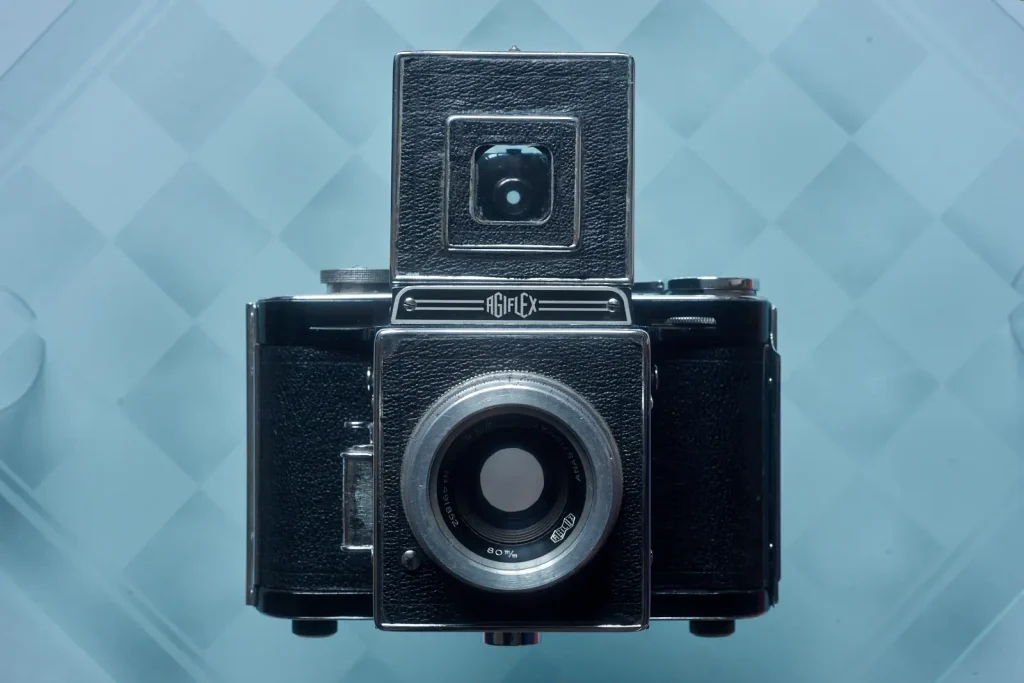
The basic layout of the Agiflex is that of a conventional 35mm SLR, but with a huge mirror box and no pentaprism. There is extensive use of leatherette. Even the baseplate and the infills on the winder are (or were originally) covered in leatherette.
Inside the Agiflex
A big door covers the entire camera back. The back is held by a groove on the right side and a sprung clip on the left. When opened the back can be totally detached. It includes a red window behind a slide. The red window is used when loading film. Film is advanced until the number 1 appears in the window, then the automatic film counter is reset. After that frame spacing is taken care of by the camera.
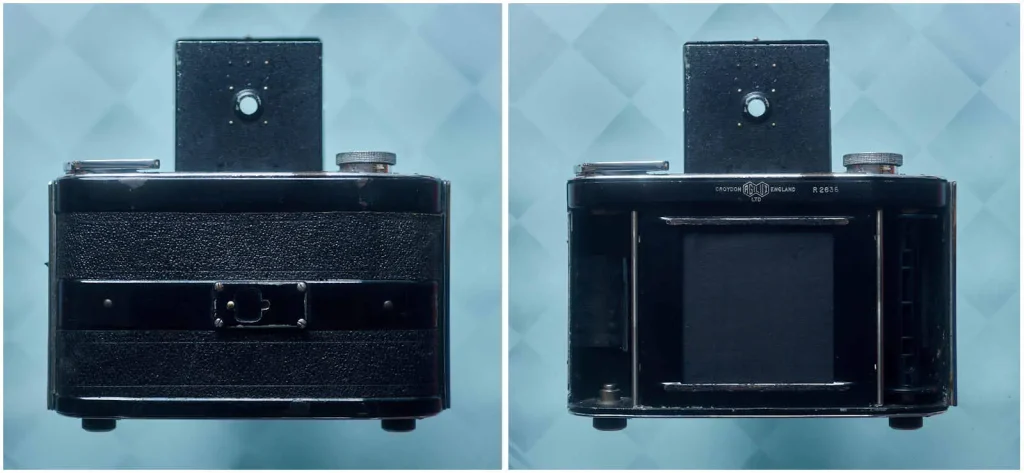
Inside the Agiflex are chambers for the film (which travels from right to left), a pair of rollers and a large horizontal cloth focal plane shutter. Only visible when the back is off is an engraving saying ‘AGILUX LTD CROYDON ENGLAND’. Also visible is a serial number for the body.
The film spools are standard 120. Film is loaded by pulling down on the knurled, sprung-loaded pinions in the bottom of the camera. The pressure plate in the Agiflex is big enough for 6×7, although no 6×7 versions were made.
Top plate features
The Agiflex film advance is via a two-stroke lever on the left of the top plate. The winder is also supposed to cock the shutter via a wire cable that passes over to the right of the camera to rotate the shutter speed dial. I’ve owned this camera for a good few years and have only just found out that the winder is also supposed to cock the shutter. I’d been setting the shutter manually by rotating the shutter speed dial about 270 degrees clockwise by hand.
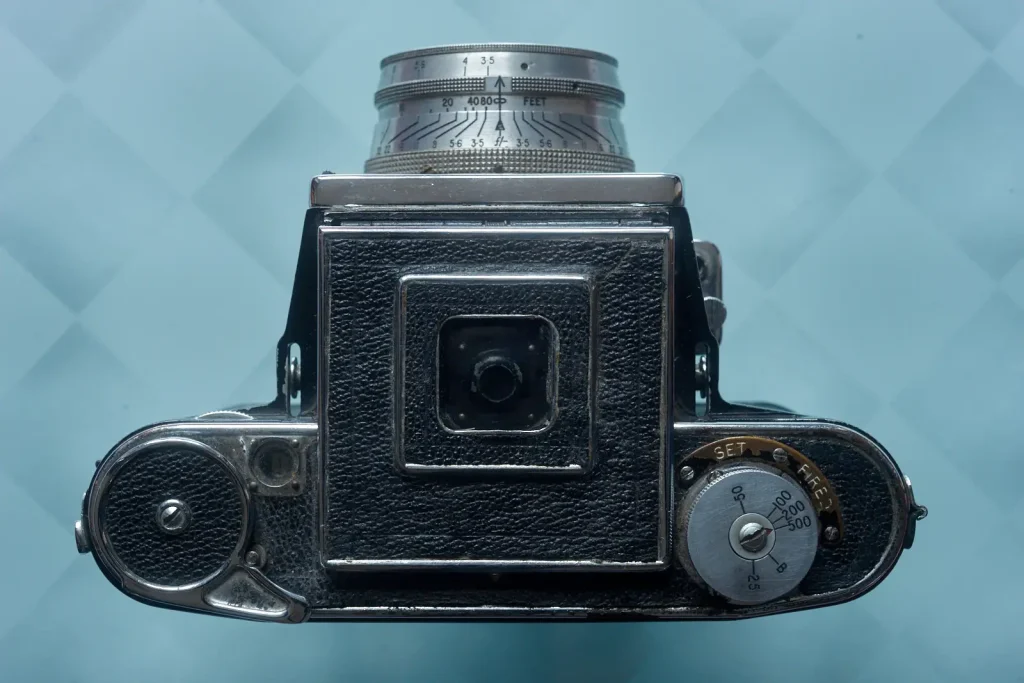
When cocked, the little arrow that points at the selected shutter speed also points to the word ‘SET’ on a plate that surrounds the dial. On releasing the shutter the arrow points at the word ‘FIRED’. Shutter speeds can be set before or after cocking the shutter by lifting the outer collar and rotating.
The cable setting the shutter is a feature copied from the Reflex Korelle. It is a common (maybe even regular) point of failure on both cameras. Cocking by rotating the dial 270 degrees by hand is a workable alternative. This was the way that users were directed to set the shutter if they wanted to make deliberate double exposures.
Viewfinder & hood
A large square leatherette covered plate with a small square window in it covers the top of the Agiflex mirror box. When it is eased up from the rear of the camera a section hinged in the other direction is released and the sides spring open to form the hood. Stowing the hood requires you to fold in the sides against their springs. You then fold the back over the viewing screen, securing down with the top/front of the hood with a little pressure catch. It sounds fiddlier than it is.
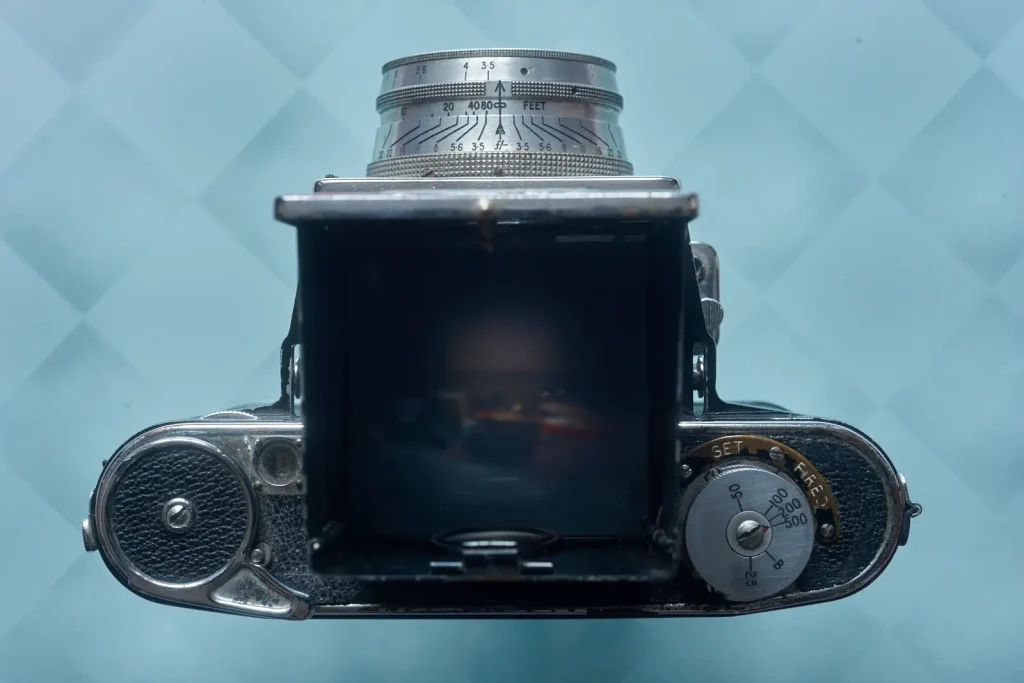
When open the hood forms a decent enough shade for the ground glass viewing screen. A fold-out magnifier is available to assist focusing.
When not deployed for focusing, the little magnifier sits over a hole in the rear of the hood. An optical viewfinder is formed by the magnifier and the window in the front of the hood. This can be used as an alternative for framing (but not focusing). It works well enough but is not quite as nice to use as the direct vision sports finders founds on TLR cameras like the Microcord and Rolleiflex.
Agiflex Lens
The Agiflex was a system camera with interchangeable lenses. The standard lens on the Agiflex Mk 1 is an 80 mm f/3.5 coated AGILUX Anastigmat. It has a manual diaphragm with 11 blades. The lenses fit via a three winged bayonet, which ensures that the focusing scale registration mark is always uppermost. Initially there were just two lenses (an 80 mm f/3.5 and a 160 mm f/5.5) plus an extension tube for close-ups. AGI later expanded the range to accommodate lenses of 240 mm and 300 mm. They also added a preset version of the standard 80 mm lens with an f/2.8 maximum aperture. AGI’s expansion of the lens range did require an enlarging of the bayonet, so my early Mk 1 Agiflex cannot take the later lenses.
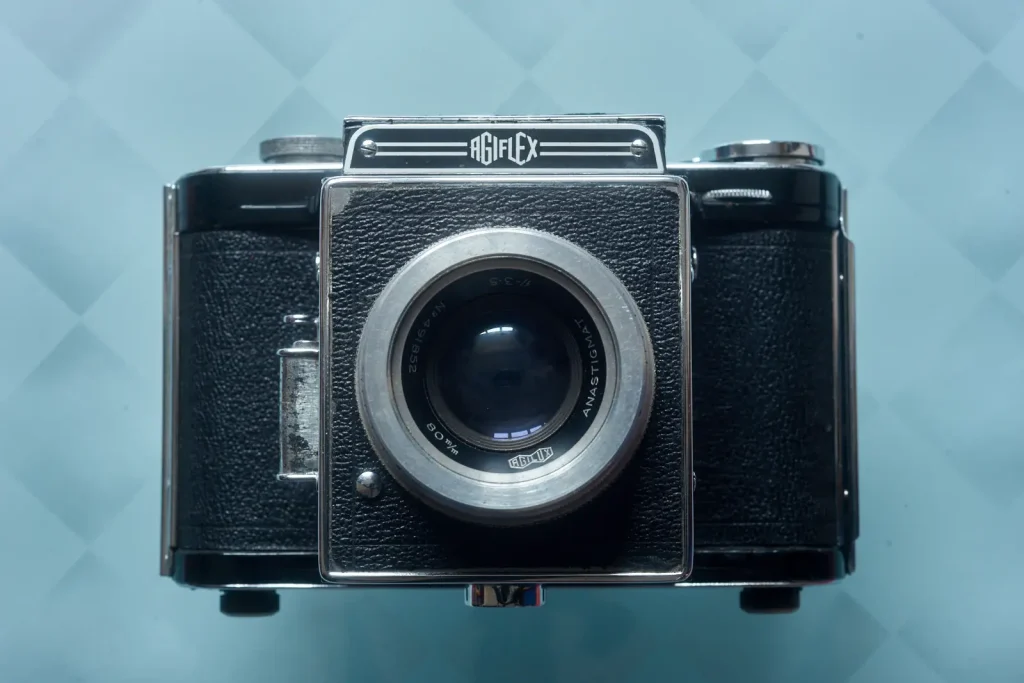
Shutter and mirror-box operation
The Agiflex shutter is fired by pressing a plunger on the right side of the mirror box. There is also a fitment for a threaded cable release.
The travel of the plunger is around 5 mm. The first part of the movement lifts the mirror against a spring. The shutter fires at the bottom of the stroke and the shutter speed dial rotates to the ‘FIRED’ position. The mirror then drops back as your thumb or finger comes off the plunger. It isn’t a sophisticated mechanism. It makes the most humble soviet Zenith camera look high-tech.
A lot of time has passed since these cameras were made. It is very possible that standards of manufacture down Purley Way were not as high as they could have been. I think I’m quite lucky that the shutter functions and the curtains seem relatively sound. Big focal plane shutters may well appear slow due to the distance they are travelling. Mine seems very slow.
For the test shots I decided to shoot everything on the top marked speed (1/500). Looking at the shutter at that speed I think it might actually be 1/25. The only way to really know is to expose some film and see how it goes.
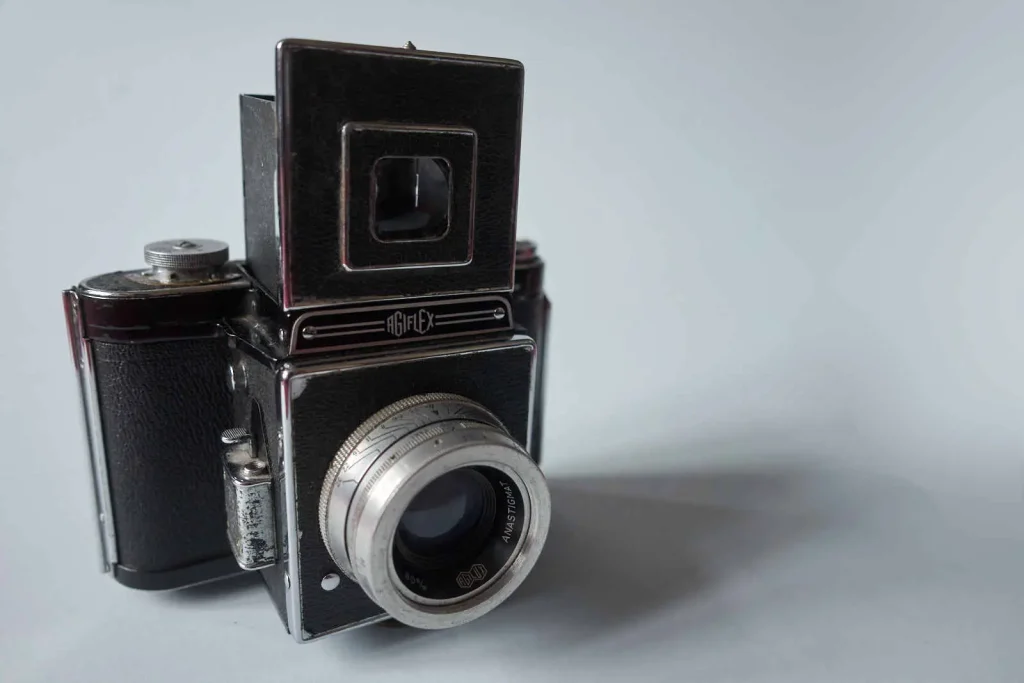
Pictures!
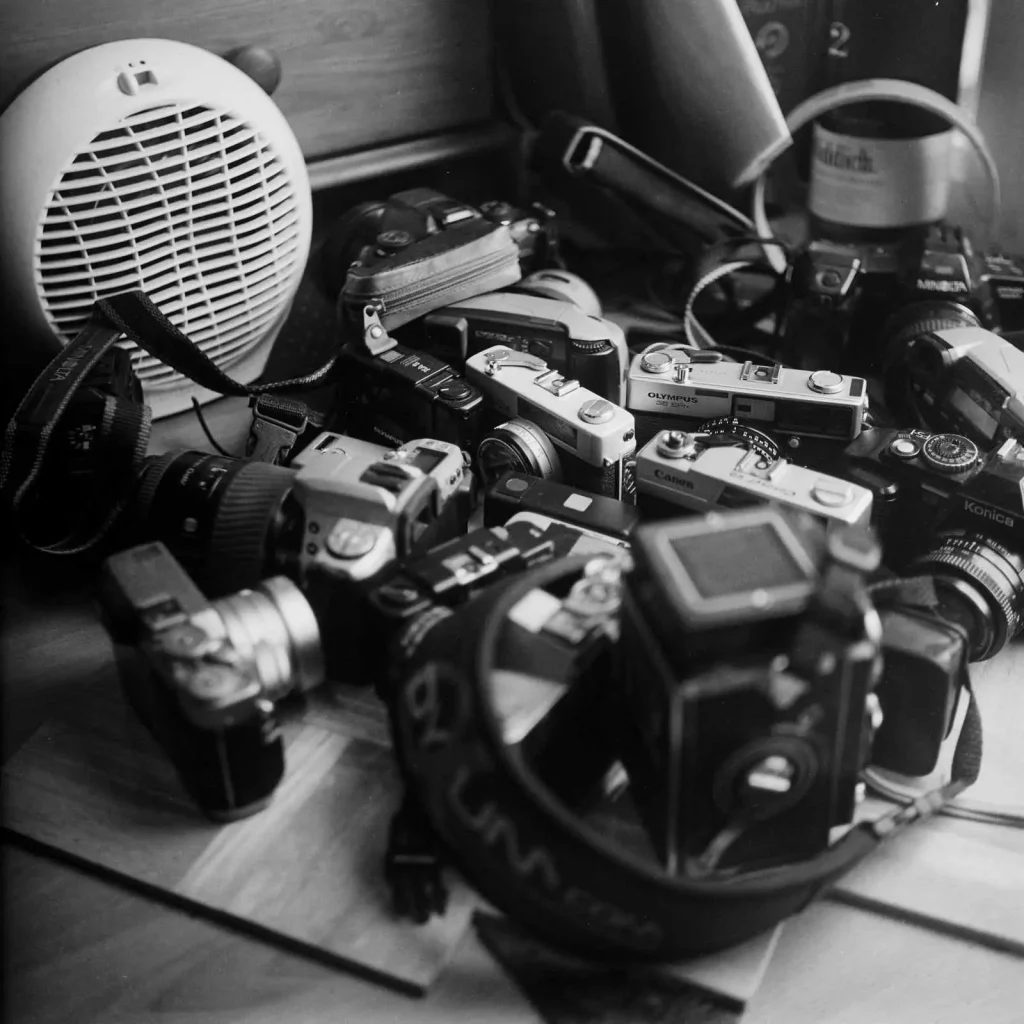
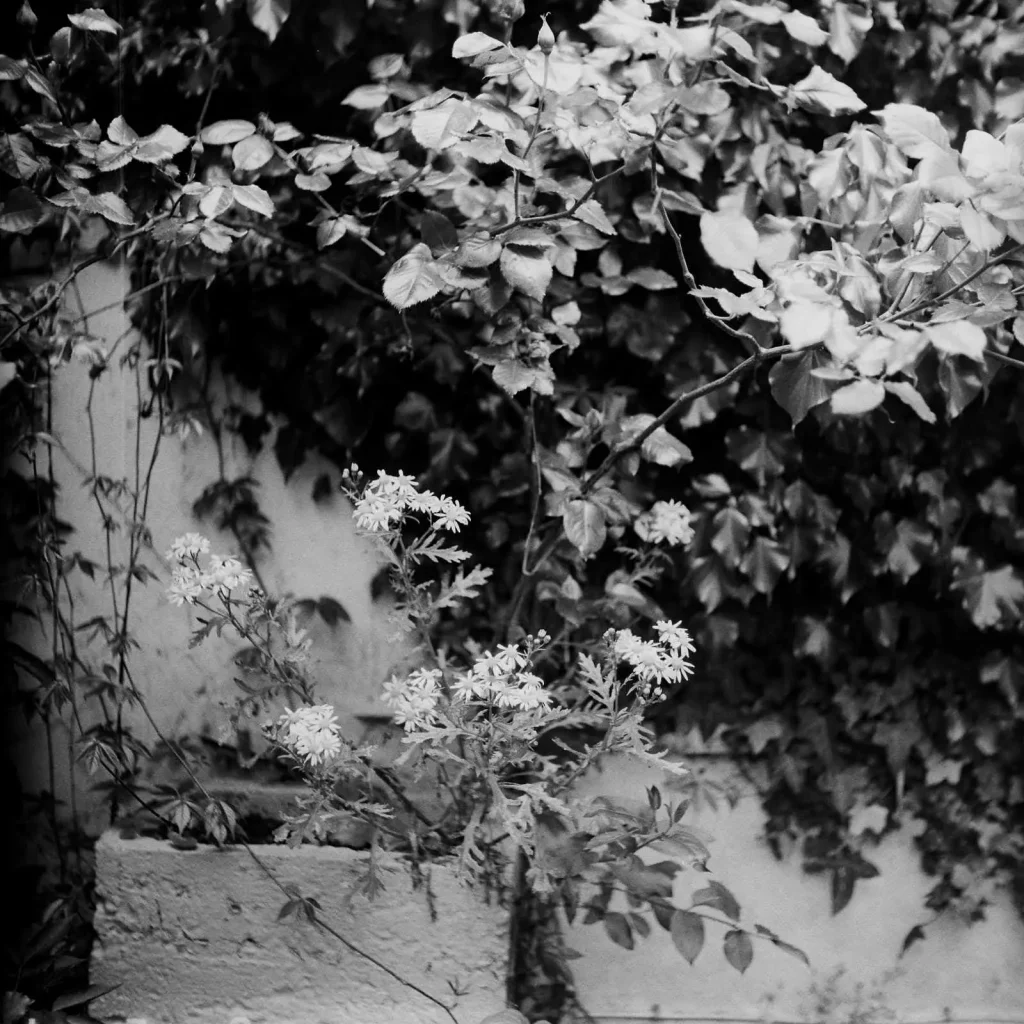
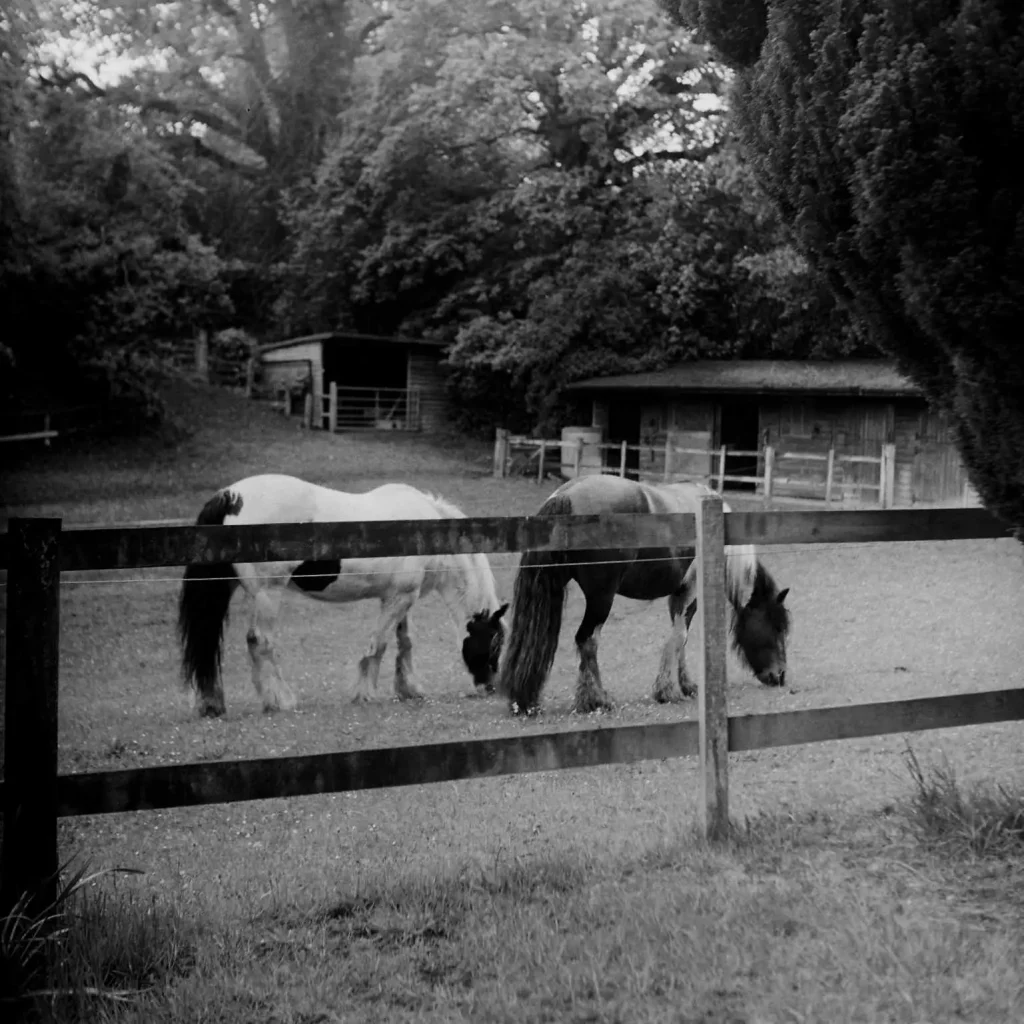
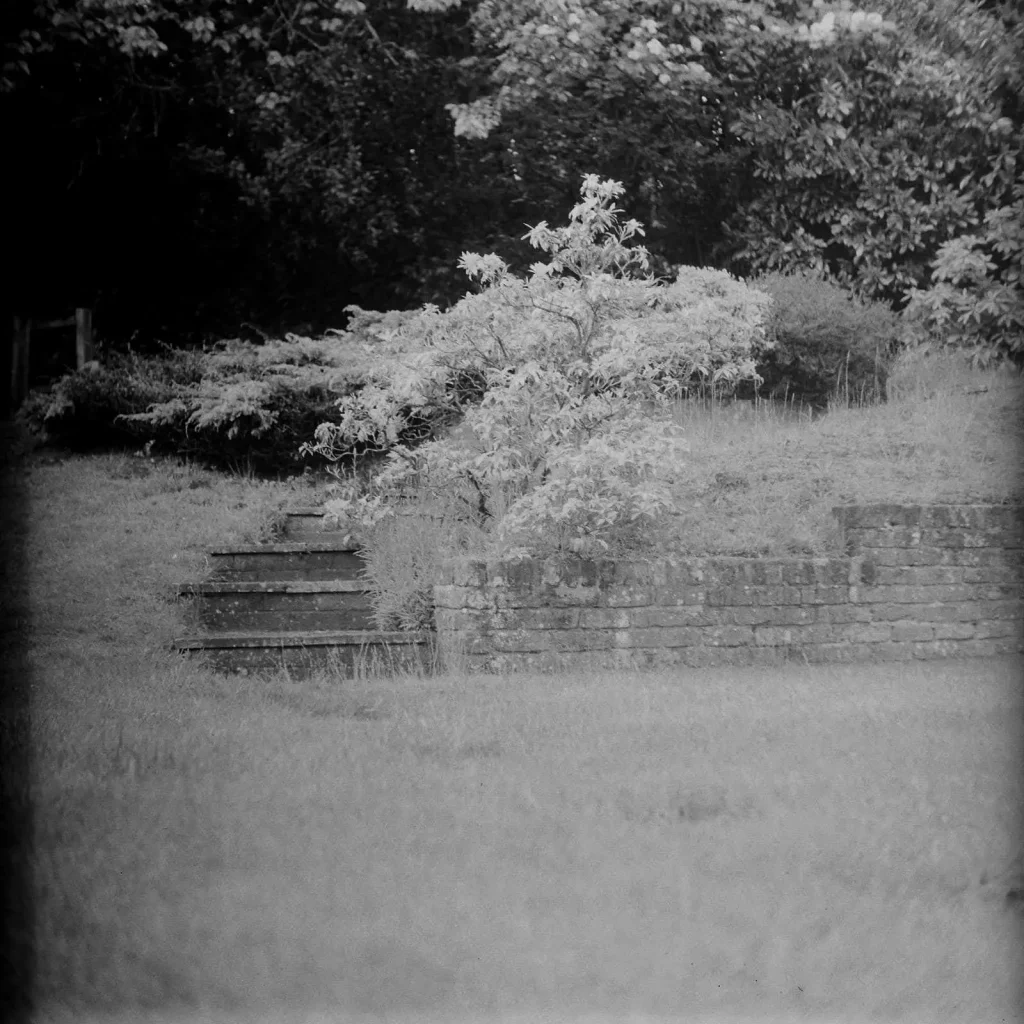
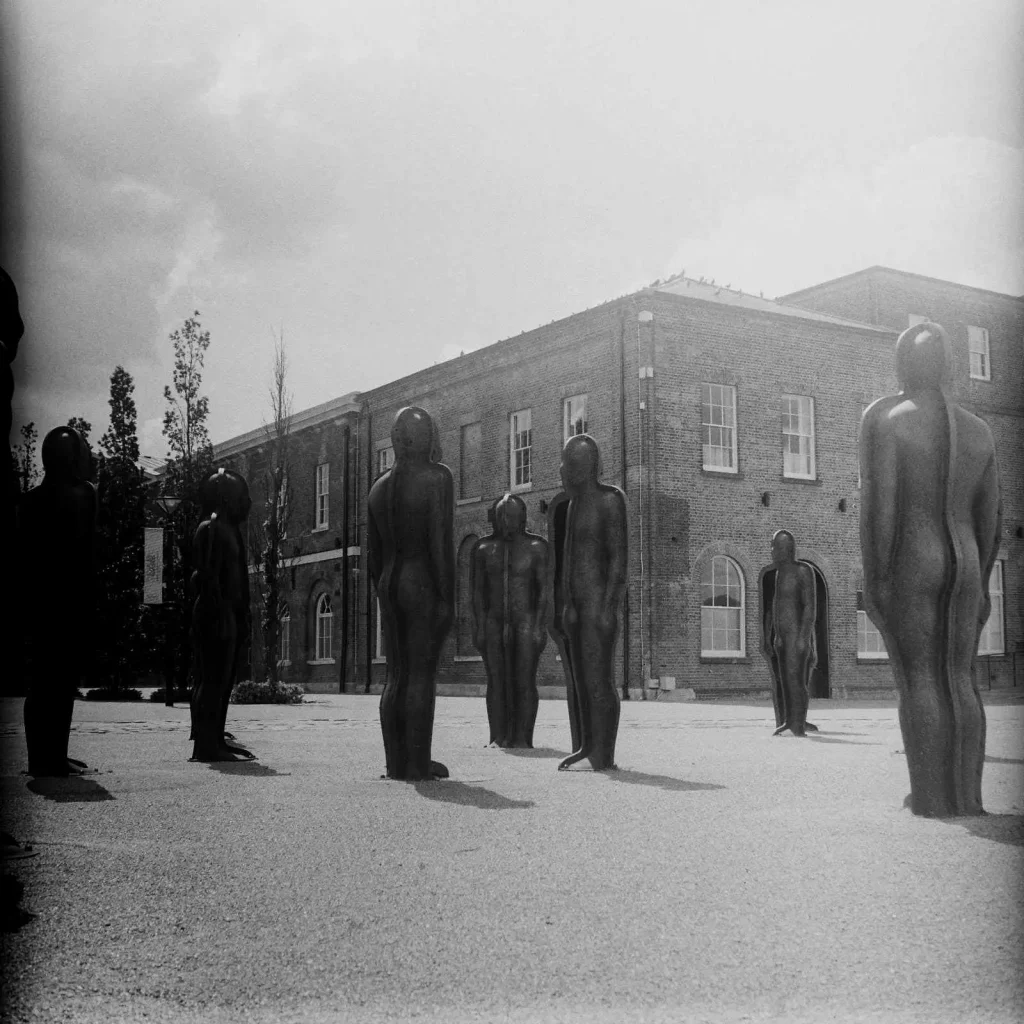
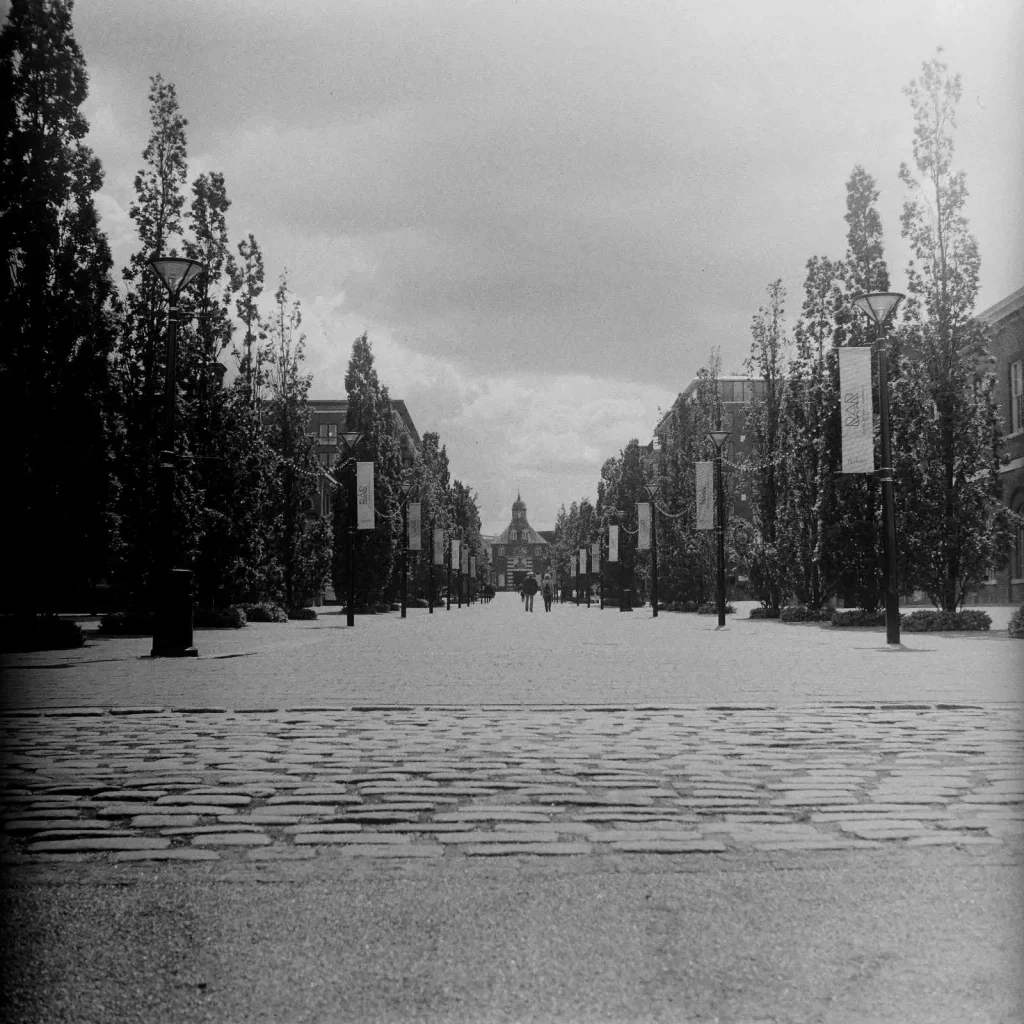
On the whole, these shots seem quite reasonably exposed – although I was exposing all the time on the assumption that the shutter was 4 stops slow. The right-hand side of some pictures is dark, which would suggest that the second curtain of the shutter was not always fully where it should be. The automatic spacing of frames seems to work well.
Where are they now?
I have a book from 1957 by Focal Press entitled ‘CAMERAS – The Facts’. This guide is aimed at members of the British public interested in purchasing cameras available at that time.
Under ‘Roll film Reflexes’ it leads off with The Agiflex III, described as possessing ‘High quality workmanship for great accuracy’. The next page features the Hasselblad 500C. That is some company to keep, even if the ordering was determined purely by the alphabet.
The stories of companies in British Manufacturing do not tend to end well. It is a jungle out there. Hostile takeovers, mergers, liquidations, recessions, disputes and cash flow problems all take their toll.
AGI decided to get out of commercial camera production in the 1960s. In the 1980s, They also got out of Croydon, moving to Poole, on the south coast of England.
Happily, they are still going. Still recognisably the same company, even using the same logo. From their website, they appear to be quite successful. They produce lighting, meteorological and navigation instruments in ship and airport environments. They also serve a number of defence contracts around the world.
The bottom line
The Agiflex is not a practical picture taking machine in modern times. But It is a fascinating slice of English Industrial history. It also helps me appreciate more modern photographic equipment.
You will often see people in photographic forums bemoaning that their own country does not have a domestic camera industry. AGI are a good example of why the UK (and France and Italy and the United States) doesn’t have a camera industry any more. Our instrument companies forsook the commercial camera market for government and specialist contracts that paid far better. Some of those companies have even thrived.
Share this post:
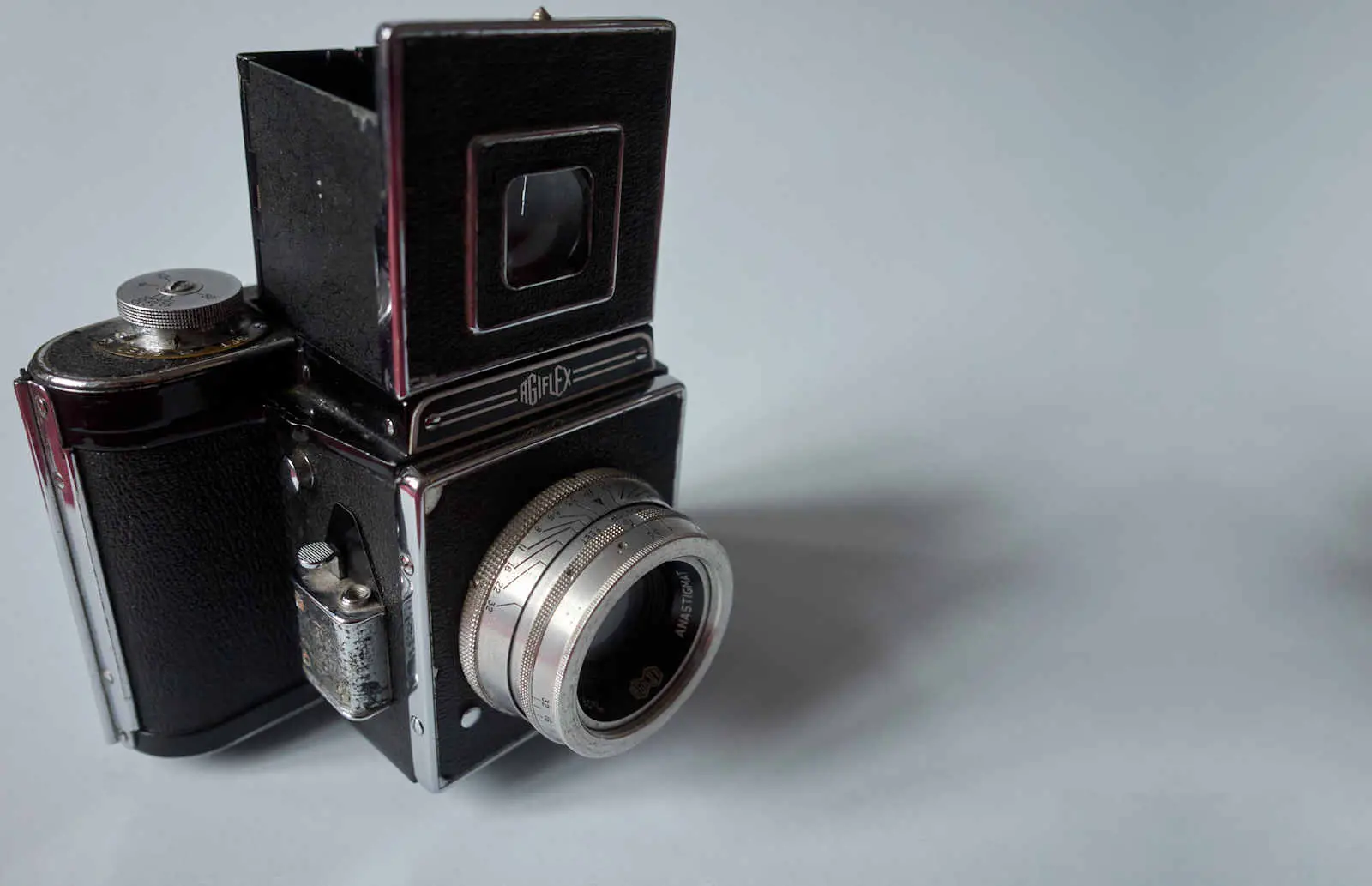








Comments
Martin on Agiflex – The British Medium Format SLR – By Bob Janes
Comment posted: 29/06/2021
Interesting camera and read, thanke for sharing that.
kind regards
Martin in Austria
Peter Roberts on Agiflex – The British Medium Format SLR – By Bob Janes
Comment posted: 29/06/2021
It certainly reflects its aero-camera heritage. I can almost imagine it being held out of an open cockpit by a flying-gloved observer.
Nice contrast in the images.
You're probably aware that the old terminal building of Croydon Airport is still there and is now a small museum. It's got a DH Heron on stilts outside. There's also an impressive RAF memorial just along the Purley Way. Both have been on my bucket list since having the misfortune of having to be in the area for work purposes a few years ago. Just got to psych myself up to go again in order to tick them off.
Comment posted: 29/06/2021
MIchael Jardine on Agiflex – The British Medium Format SLR – By Bob Janes
Comment posted: 29/06/2021
Martin South of France on Agiflex – The British Medium Format SLR – By Bob Janes
Comment posted: 30/06/2021
Comment posted: 30/06/2021
Dave Ireland on Agiflex – The British Medium Format SLR – By Bob Janes
Comment posted: 24/04/2022
The later Mk 3 has not been used so far. Oddly built cameras, I thought. Quite solid bodies with flimsy backs that engendered no confidence in their light tight ness.
Comment posted: 24/04/2022
Christopher Davies on Agiflex – The British Medium Format SLR – By Bob Janes
Comment posted: 24/07/2022
I also have a Goertz Taro Tenax folding camera in its original box, I believe from twenties or thirties and which Iwould like to know more about. Any info much appreciated
Simon Gascoigne on Agiflex – The British Medium Format SLR – By Bob Janes
Comment posted: 28/04/2024
Comment posted: 28/04/2024